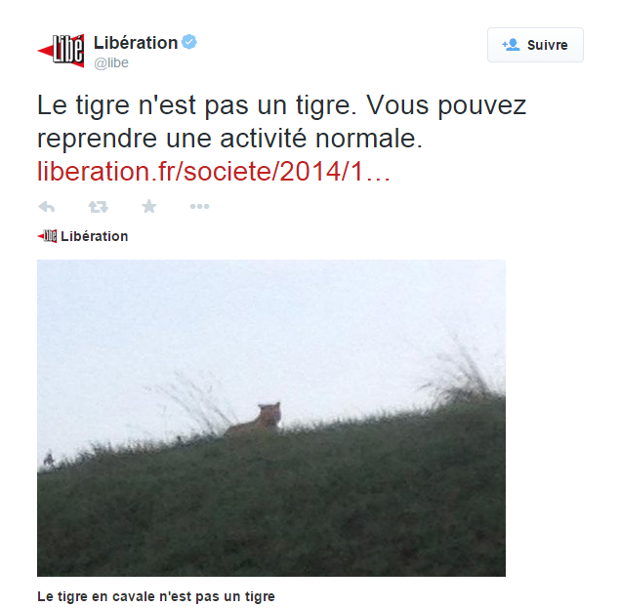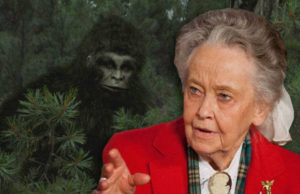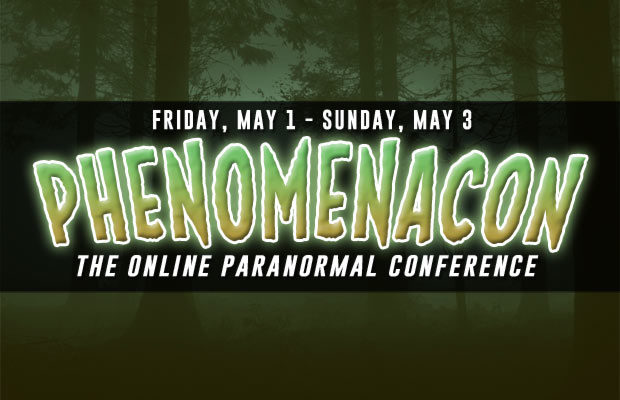French Authorities on The Hunt as Sightings of “Alien Big Cat” Prowling Paris Surface
“Then came the reports of a large wild cat on the loose, slinking around the outskirts of the French capital and eluding a hunting squad that included officers armed with tranquilizer guns and a helicopter equipped with a thermal detector. As of Friday evening, they proved no match for the elusive cat, which officials estimated weighed at least 100 pounds, based on the size of its tracks.” [1]
“Mysterious Visitor, Clad in Fur, Puts Paris on Edge” Dan Bilefsky for the New York Times, Friday November 14th, 2014.
“The alarm was raised on Thursday when a woman spotted an animal near the local supermarket. A dozen fire trucks, a helicopter with heat-seeking equipment, 200 firefighters, gendarmes and police officers armed with stun guns, and a sniffer dog specially trained to track bears and large game spent most of the day searching for the animal, while schoolchildren got a police escort home and local residents were warned to stay indoors.” [2]
“Paris ‘Tiger’ on the prowl not a tiger at all, say French Police” The Guardian, Friday November 14th.
ADVERTISEMENT
A few weeks ago, readers familiar with the phenomenon of phantom panthers, or Alien (or Anomalous) Big Cats (A.B.C.’s, as they are often called), who may have read some of the stories quoted above would have been able to predict how the whole thing unfolded: The French hunting squad deployed by the state followed a dwindling trail of evidence throughout the Parisian countryside until they came to an official conclusion that there was no large cat prowling the outskirts of Paris, there never had been, and anyone who saw anything like that mistook a large house cat for a fully-grown tiger. The 24-hour news cycle put a bow on the whole story while the handful of individuals who really did see a big cat in the countryside surrounding Paris last week were left scratching their heads, probably wondering how something so huge and wild might have been able to slip away unnoticed. Or did they imagine the whole thing?
 If they did, they’re far from the only individuals who have seen large, black felines far beyond the expected range of any such animal. Strange as it may sound, incidents like this are not at all uncommon throughout the world, although they seem to happen with more regularity in certain areas. The midwestern United States are a good place to have an encounter with an anomalous feline. Based on sheer quantity of reports, you’d also have a good chance of spotting one in the vicinity of Mount Diablo, California, another apparent American focal point for phantom panther encounters. [3]
If they did, they’re far from the only individuals who have seen large, black felines far beyond the expected range of any such animal. Strange as it may sound, incidents like this are not at all uncommon throughout the world, although they seem to happen with more regularity in certain areas. The midwestern United States are a good place to have an encounter with an anomalous feline. Based on sheer quantity of reports, you’d also have a good chance of spotting one in the vicinity of Mount Diablo, California, another apparent American focal point for phantom panther encounters. [3]
Two countries with what appear to be some of the highest concentrations of phantom cats in the world are the United Kingdom and Australia. To cite a handful of examples without rehashing too much of the literature on the topic:
In 2001, a study carried out by Deakin University in regard to a possible big cat population in the Grampian Mountains of Victoria, Australia, asserted that their existence was “beyond reasonable doubt.”[4] A separate study by the New South Wales State Government in 2003 concluded the presence of a colony of wild big cats in the bush near Sydney was “more likely than not.” [5]Despite the ubiquity of eyewitness reports to which these quotations attest, to date, no one has been able to substantiate them with physical proof.
Across a few ponds to the United Kingdom, the presence of phantom big cats has been a matter of tense public debate since at least the early 1960’s. Usually these cats appear in “flaps” (sightings that suddenly boom and then abruptly cut off) and are given a catchy name in the press reflecting some local flavor: There is the Beast of Bodmin Moor, the Surrey Puma and the Galloway Puma, among many others. There is also the Beast of Exmoor, who was, like the Parisian Panther, the target of an unsuccessful hunting party deployed by the state (in this case, the British Ministry of Agriculture, bowing to public pressure to take some kind of action against the wild big cats that were being blamed for the costly deaths of livestock in the area). To be sure, this handful of names represent just a few of the thousands of reports of anomalous big cats to come out of the U.K. in modern times. And while there have been a few confirmed kills and captures over the past century in the U.K.,[6] the mystery of most of these phantom cats persists.
 The most curious skill that all these cats seem to share is an ability to evade those who go looking for them: in the case of the Parisian Panther in November, the search was called off after only 24 hours, with officials citing an analysis of tracks that led to an estimation of its weight as “at least 100 pounds.” [7] Enough to rule out a fully grown Siberian tiger, without a doubt, but quite a bit larger than your average housecat. Certainly large enough make one question the decision to call off the search after only 24 hours. With the average weight of, say, a North American mountain lion clocking in between 75-175 pounds,[8] I think it’s safe to say that the Parisian Panther, which weighed in official estimation “at least 100 pounds” (emphasis added) was something much larger than a housecat, and probably more like an animal we’d describe as a “big cat.”
The most curious skill that all these cats seem to share is an ability to evade those who go looking for them: in the case of the Parisian Panther in November, the search was called off after only 24 hours, with officials citing an analysis of tracks that led to an estimation of its weight as “at least 100 pounds.” [7] Enough to rule out a fully grown Siberian tiger, without a doubt, but quite a bit larger than your average housecat. Certainly large enough make one question the decision to call off the search after only 24 hours. With the average weight of, say, a North American mountain lion clocking in between 75-175 pounds,[8] I think it’s safe to say that the Parisian Panther, which weighed in official estimation “at least 100 pounds” (emphasis added) was something much larger than a housecat, and probably more like an animal we’d describe as a “big cat.”
 This talent for evasion has contributed to a body of impressively implausible official explanations throughout history. During these cat flaps owners of zoos are questioned, exotic pet owners are made the subject of public scrutiny, and there is suddenly a great deal of attention paid to the routes of circuses travelling in the area. Loren Coleman has written at length about the “Circus Train-wreck” scenario which is often trotted out during mystery animal flaps in his book Mysterious America and elsewhere. [9] The case of the Parisian Panther was no different, although the circus explanation was quickly dismissed by officials when it was raised:
This talent for evasion has contributed to a body of impressively implausible official explanations throughout history. During these cat flaps owners of zoos are questioned, exotic pet owners are made the subject of public scrutiny, and there is suddenly a great deal of attention paid to the routes of circuses travelling in the area. Loren Coleman has written at length about the “Circus Train-wreck” scenario which is often trotted out during mystery animal flaps in his book Mysterious America and elsewhere. [9] The case of the Parisian Panther was no different, although the circus explanation was quickly dismissed by officials when it was raised:
“The Montevrain mayor’s office dismissed the idea that the big cat could have escaped from a circus that was in the town until Saturday, Le Parisien reported.” [10]
This pack of ghostly dark cats prowling our headlines leads one to wonder about the real source of these stories. Not the cats themselves, but the experience of the people who report them. What are they actually experiencing? Real, flesh-and-blood big cats who have lost their way? Are there really so many absent-minded exotic pet owners in the world? And if there were, is it realistic to suppose that their lost pets would never be recovered? And in the event that the phenomenon of phantom panthers is purely hallucinatory, why does everyone keep hallucinating panthers? Author and researcher Linda Godfrey posed a very similar conundrum regarding lake/sea monster reports in her 2014 book American Monsters:
“It’s intriguing that eyewitnesses almost always see creatures that closely resemble animals that could have once been there and that look and behave appropriately for their environments. No one reports seeing something that resembles, say, a giant marshmallow man from the movie Ghostbusters walking across the waves, as one might expect if sea monsters were appearing as willy-nilly products of individual imaginations. And there are many examples of multiple witnesses seeing the same thing at the same time.” [11]
Indeed, we could ask the same question of a number of phantom animal categories. Godfrey was specifically referring to the tendency of aquatic cryptids to resemble prehistoric plesiosaurs, but the above paragraph elucidates the phenomenon of phantom big cats, black dogs in the U.K., North American Thunderbirds, even the ubiquitous reports of hairy humanoids across the globe, along with many others. If the experience of these creatures is hallucinatory, why do our hallucinations seem to (for the most part) keep fitting into these categories? Why panthers, and not rhinos? Why do people keep seeing big cats in the Grampian mountains, and not wolves?
When people report experiences of animals who appear able to manifest and un-manifest physical form at will, in a form that is either non-native to their environment or long extinct within it, in short, animals that cannot really be flesh-and-blood, why do they tend to experience these encounters with forms occupying discrete, identifiable categories bound to the environments in which the encounter takes place?
The apparent existence of these categories (to which, I acknowledge, there are notable exceptions) seems to indicate an imperceptible structure which forms the basis of most of our encounters with mysterious creatures. It is hard to say with certainty whether this structure is internal (human beings are somehow predisposed to hallucinate hairy hominids, panthers, etc.) or external (the experiential source of the phenomenon takes these forms for reasons unknown to us). The tendency of these animals to leave traces like hair, tracks, and savagely mutilated livestock leads me to lean towards the external source. Either way, there is a broader factor which seems to underlie the experience of mysterious animals that both mainstream social science and fringe/fortean research have not yet satisfactorily identified.
But I’m getting ahead of myself. It would have been pointless for the the French authorities to keep looking after 24 hours. No one has ever caught a phantom feline before, so why bother tracking an animal that no longer exists?
[1] http://www.nytimes.com/2014/11/15/world/europe/tiger-wildcat-paris-disneyland.html?ref=science Accessed December 1st, 2014
[2] http://www.theguardian.com/world/2014/nov/14/paris-tiger-big-cat-france-police-search Accessed December 1st, 2014
[3] Mysterious America, Loren Coleman. Pocket Books: 2001. P 25.
[4] John Henry, “Pumas in the Grampians Mountains: A Compelling Case? An Updated Report of the Deakin Puma Study”, Deakin University Press, Melbourne, May 2001. Conclusion quoted in Atkinson (2003)
[5] http://www.smh.com.au/articles/2003/11/01/1067597200706.html Accessed November 18th, 2014.
[6] http://scotcats.online.fr/abc/photoalbum/cannich.html Accessed November 18th, 2014
[7] http://www.nytimes.com/2014/11/15/world/europe/tiger-wildcat-paris-disneyland.html?_r=0 Accessed December 1st, 2014
[8] http://www.nps.gov/brca/naturescience/mountainlion.htm Accessed December 4th, 2014
[9]http://cryptomundo.com/cryptozoo-news/circus-wreck/ Accessed December 3rd, 2014
[10] http://www.bbc.com/news/world-europe-30049216. Accessed December 1st, 2014.
[11] American Monsters, Linda Godfrey. Tarcher/Penguin: 2014. P. 211
MORE GREAT STORIES FROM WEEK IN WEIRD:











You must be logged in to post a comment Login